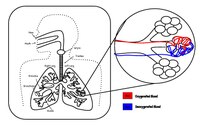
Photo from wikipedia
Proton‐exchange membrane fuel cell (PEMFC) operation and performance degrade when particulate matter (PM) present in the reactant gas stream is collected in the porous structure of the gas diffusion layers… Click to show full abstract
Proton‐exchange membrane fuel cell (PEMFC) operation and performance degrade when particulate matter (PM) present in the reactant gas stream is collected in the porous structure of the gas diffusion layers (GDL). Interaction of PM carried by the gas stream and their capture efficiency by fibrous structure of GDLs is numerically investigated at various levels of relative humidity (RH) and different particle sizes. For small particles (sub‐micron sizes), the Brownian diffusion mechanism is dominant, while transitioning to interception and inertial impaction mechanisms occur as particle size increases (micron sizes or larger). It is found that high humidity levels result in higher diameter and lower density of PM, lower air density, and lower particle bounce due to the absorption of water vapor in the PM. Of these four effects, the first is the most important and the third is the least important. As humidity level is increased, particle capture efficiency decreases for small particles, but increases for large particles. The present study implies that a filter capable of removing large particles must be installed in the upstream reactant gas supply line to avoid the accumulation/clogging of PM in GDL structure.
Journal Title: International Journal of Energy Research
Year Published: 2021
Link to full text (if available)
Share on Social Media: Sign Up to like & get
recommendations!